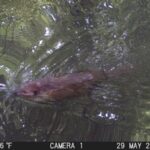As the March days lengthen with the first hints of spring, the Alliance will be keeping a sharp eye out for the annual migration of the alewife herring. Their return is a sign of the success of their reintroduction into the river after an absence of over 300 years, but why is this little fish so important to the Bronx River’s habitat?
Known to scientists as Alosa pseudoharengus, the alewife’s annual return was avidly awaited by both Native Americans and European colonists. The legendary Squanto (Tisquantum) taught the newly arrived Plymouth pilgrims about these spring migrations, and he also showed them how to use alewives to fertilize their cornfields, a technique used by New England gardeners to this day.
Here in the Bronx River the silvery alewife is an important part of the river’s ecosystem. It is a major food source for bluefish and striped bass, schools of which will often follow the returning alewives for many miles up estuaries and rivers. The alewife is also eaten by such spectacular birds as herons, ospreys, cormorants, and even bald eagles – and they’re healthier for them, too, since they return from the ocean with fewer toxins in their bodies than most freshwater fishes. They also feed eels, gulls, raccoons, crayfish, and turtles, and as the only known host for the freshwater mussel known as the “alewife floater,” the alewife may help reestablish this native population of filter feeders that will help clean the water.
Ranging from Newfoundland to South Carolina, the alewife is spawned in fresh or brackish water, after which both juveniles and adults return to the ocean until the next spring, when they return to the very waters in which they themselves were spawned in to begin a new round of their life cycle. A single alewife may do this for as many as seven or eight years in succession.
This migratory characteristic, however, leaves the alewife vulnerable to human actions that cut off their native spawning grounds, and since the construction of the first mill dams at West Farms in the 1680s the alewife disappeared from the Bronx River. As part of ongoing environmental restoration efforts the Alliance reintroduced the alewife into the Bronx River in 2006 and 2007, but the challenge now is to ensure that this reintroduction takes permanent hold by constructing “fish passages” to get the returning alewives past the dams to the fresh still waters upstream.
Stephen Paul DeVillo





